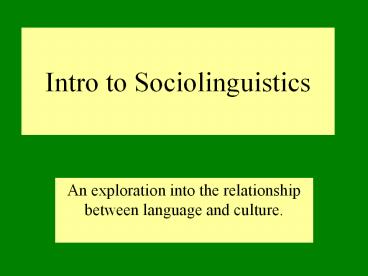Intro to Sociolinguistics PowerPoint PPT Presentation
1 / 26
Title: Intro to Sociolinguistics
1
Intro to Sociolinguistics
- An exploration into the relationship between
language and culture.
2
Fundamental Question
- a. What is the relationship between language and
culture? - b. Humans are the only animal to have culture.
- c. Humans are the only animal to have language.
- d. How do the two connect?
- e. What is language? what members of a
particular society speak (Wardhaugh 1).
3
Different Meanings of Language
- a. I know I don't speak English correctly.
- b. Most French-Canadians prefer to speak
French, even though they can - speak English too.
- c. The treaty wasn't ready to sign until both
sides had a chance to look over - the language.
- d. A polyglot is someone who knows many
languages. A linguist is someone - who can analyze language structure.
- e. English is the most widely-spoken language
in the world. - f. American thought and language.
- g. I need to work on my language skills.
- h. When Fred speaks to Sam, sometimes he
uses English and sometimes Arabic.
4
Lets have a go at discussion question 4 on page
7 of Wardhaugh.
5
Three Views of Language
- Language as Grammar
- Language as communication
- Language as thing
6
Language as Grammar
- The object of a science of linguistics (Saussure).
7
Noam Chomsky (1928-)
- Syntactic Structures
- Review of Skinner Verbal Behavior (1959)
Universal Grammar difference between surface
structure and deep structure in language
8
Grammar
- Three sub-systems
- Representational
- Phonology (sounds), graphic, gestural
- Lexical
- morphology words and morphemes
- (Syn)tactic syntax
9
Language as communication
- Language as Text.
- The Interaction of People
- The Interpretation of Texts
- What do you communicate? Ideas? Emotions?
Intentions? - How do you communicate?
- Messages
- The interpretation of messages
- The construction of messages
10
(No Transcript)
11
Language as thing
- Language as an element in social constructs.
- Language planning, code switching, dialect
debates.
12
(No Transcript)
13
Note to distinguish between and language and
communication, look at the following questions
- 1. Is language as Dawkins suggests part of the
DNA of homosapiens? - 2. Is there a creative component (the
horrible honeybee story)
14
Competence v. Performance
- Langue v parole
- Structure v event
- Structural v communicative
- universal v dialect
15
Approaches to language and culture
- Wardhaugh, quite sensibly, argues that
sociolinguistics is both macrolinguistic and
microlinguistic - Microlinguistic-- language emphasis
- Macrolinguistics social emphasis
- Whorf, Politeness French Structuralism
(Lévi-Strauss). - Communicative approaches p. 14
- Language and power (Fairclough), Social
construction of reality (Berger and Luckmann)
Language and Symbolic Power (Bourdieu)
Pragramatics (Austin) - Use Approaches
- Language Planning, Multilingualism
16
Lets take five more minutes to chat about
discussion questions 2, 5, and 6 on pp. 15 and 16
of Wardhaugh.
17
Relations between language and culture Wardhaugh
pp. 9-11
- Social structure may influence or determine
linguistic structure and/or behaviour - Linguistic structure/behaviour influences or
determines social structure (Whorfian hypothesis)
18
3. Language and society affect each other4. No
relationship at all between language and culture
19
Desperate Definitions Sociolinguistics is an
attempt to find correlations between linguistic
structure and social structure
20
Sociolinguists whatever it is, is about asking
important questions concerning the relationship
of language to society (Wardhaugh 11)
21
This is not reassuring
- Even our textbook seems unable to give us a
straightforward, agreed upon definition of
sociolinguistics. - Lets try the discussion questions on page 12 of
Wardhaugh. Get into groups of 4 or 5 and take 15
minutes to go over questions 1 and 2.
22
Methodological principles Wardhaugh p. 181.
Cumulative2. Uniformation3. Convergence4.
Subordinate shift5. Style shifting6.
Attention7. Vernacular8. Formality
23
More Discussion
- There is a connection between questions 1 and 4
on p. 19 of Wardhaugh. What can we say about
historical vs synchronic linguistics, about
written vs spoken language?
24
Squishy
- I told you sociolinguistics is squishy. Can you
all remind me what we learn about our topic of
study from chapter 1 of Wardhaugh and this
pitiful powerpoint? What is most important? 3
things? 5 things? 10 things? - What will you remember in 10 years about it?
25
Irrelevant but interesting
26
L. Ron Hubbard
- All men are your slaves," he once wrote in a
diary entry unearthed during a 1984 lawsuit. He
reportedly once claimed to have written a
manuscript that contained such brutal truths that
anyone who read it went insane or committed
suicide.

